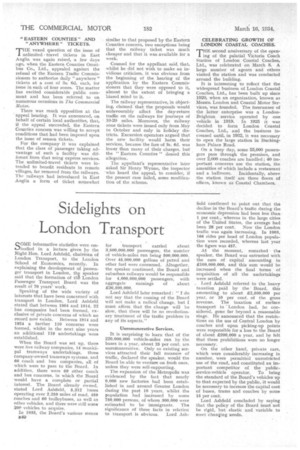Sidelights on London Transport
Page 50

If you've noticed an error in this article please click here to report it so we can fix it.
SCOME informative statistics were emL-Thodied in a lecture given py the Right Hon. Lord Ashfield, chairman of London Transport, to the London School of Economics, recently. In explaining the development of passenger transport in London, the speaker said that the formation of tht London Passenger Transport Board was the result of 70 years' work.
Speaking of the wide variety of interests that have been concerned with transport in London, Lord Ashfield stated that between 1904 and 1914, 22 bus companies had been formed, exclusive of private concerns of which no record now exists. Between 1914 and 1924 a further 110 concerns were formed, whilst in the next nine years an additional 119 undertakings were established.
When the Board was set up, there were five railway companies, 14 municipal tramways undertakings, three company-owned tramways systems, and 66 coach and bus companies, all of which were to pass to the Board. In addition, there were 69 other coach and bus concerns, in which the Board would have a complete or partial interest. The Board already owned, stated Lord Ashfield, 5,312 buses operating over 2,259 miles of road, 459 coaches and 60 trolleybuses, as well as other vehicles, and there were still some 200 vehicles to acquire.
In 1933, the Board's various means 840 for transport carried about 3,500,000,000 passengers, the number of vehicle-miles run being 500,000,000. Over 45,000,000 gallons of petrol and other fuel were consumed. Altogether, the speaker continued, the Board and suburban railways would be responsible for 4,000,000,000 passengers, with aggregate earnings of about £36,500,000.
Lord Ashfield later remarked: "I do not say that the coining of the Board will not make a radical change, but must affirm that the change will be slow, that there will be no revolutionary treatment of the traffic problem in any of its aspects," Unremunerative Services.
It is surprising to learn that of the 220,000,000 vehicle-miles run by the buses in a year, about 25 per cent. are unremunerative. Only as existing services attracted their full measure of traffic, declared the speaker. would the Board be able to venture on fresh ones, unless they were self-supporting.
The expansion of the Metropolis was evidenced by the fact that nearly 9,000 new factories had been established in and around Greater London during the past 10 years, whilst the population had increased by some 750,000 persons, of whom 300,000 were estimated to be immigrants. The significance of these facts in relation to transport is obvious. Lord Ash
field continued to point out that the decline in the Board's traffic during the economic depression had been less than 1 per cent., whereas in the large cities of the United States, the average had been 28 per cent. Now the London traffic was again increasing. In 1903, 166 rides per head of London population were recorded, whereas last year the figure was 457.
At the moment, remarked' the speaker, the Board was entrusted with the care of capital amounting to £109,000,000, and this sum would be increased when the final terms of acquisition of all the undertakings were settled.
. Lord Ashfield referred to the heavy taxation paid by the' Board, this amounting to about £2,500,000 per year, or 10 per cent. of the gross revenue. The taxation of surface transport in London had, he considered, gone far beyond a reasonable stage. He announced that the restrictions on the use of Central London by coaches and upon picking-up points were responsible for a loss to the Board of about £200,000 a year, and he felt that these prohibitions were no longer necessary.
On the other hand, private cars, which were considerably increasing in number, were permitted unrestricted use of the road, and constituted an important competitor of the publicservice-vehicle operator. To bring the standard of the Board's vehicles up to that expected by the public, it would be necessary to increase the capital cost of buses, trams and coaches by some 15 per cent.
Lord Ashfield concluded by saying that the policy of the Board must not be rigid, but elastic and variable to meet changing needs.




















































































